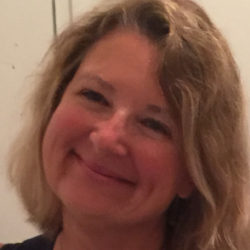
Heidi Harley
Dolphins Stay in Touch: Whistles, Clicks and Blats
About the Speaker
Dr. Heidi Harley is a comparative psychologist who studies how dolphins think. She began her dolphin life as a whale and dolphin trainer at Miami Seaquarium’s Flipper TV lagoon in the 1980s after growing to love the natural world on the coastal beaches of South Carolina. She was educated in philosophy at the University of Colorado, Boulder, and learned how to study animal thinking at the University of Hawaii Manoa in every marine mammal facility on the island of Oahu – Lou Herman’s dolphin lab on the beaches of Ala Moana, the Navy lab across from Gilligan’s Island in Kaneohe Bay, Sea Life Park at the foot of the Koolau Mountain Range. While on Oahu, Harley also mothered an orphaned sea lion complete with middle-of-the-night feedings and antiphonal calling (sea lion calves and their mothers call back and forth to each other). Dr. Harley has studied dolphins at a dozen facilities in the United States and collaborated with marine mammal researchers from around the world. Through the years, she’s had research appointments at Disney’s The Seas, Mote Marine Laboratory, Woods Hole Oceanographic Institute, the Naval Ocean Systems Center, The Mirage Hotel’s Dolphin Habitat, The Kewalo Basin Marine Mammal Laboratory, and the University of Hawaii. Harley has published articles about dolphin cognition and echolocation in Nature, Animal Behaviour, and other scientific journals as well as chapters in books for academia and for the public – most recently Deep Thinkers: Inside the Minds of Whales, Dolphins, and Porpoises. She’s on the editorial board of Aquatic Mammals and a Psychonomics Fellow. Her work has been highlighted in radio, television, magazines, newspapers, and in an installation at the Muséum National d’Histoire Naturelles in Paris. She’s won awards for teaching and science communication. Professor Harley teaches courses in comparative psychology, environmental studies, and animal wellbeing at New College of Florida. She was recently appointed as the Peg Scripps Buzzelli Endowed Chair in Psychology. She’s been affiliated with NCF’s Environmental Studies program since 2002, often as its director. She’s highly invested in animal welfare and has worked on the Association of Zoo and Aquarium’s Dolphin Welfare Initiative, Sea World’s Blue World Initiative, and is currently a member of animal care and welfare committees at the Lemur Conservation Foundation, Disney’s Animal Programs, Clearwater Marine Aquarium, and the South Florida Museum. Talk Overview: From the surface, sometimes the ocean can look like a quiet, calm space. In fact, it's full of noise! Sound travels more than four times faster in water than in air, and the animals that live in the ocean take advantage of that speed. Bottlenose dolphins (think Flipper) live in societies that come together and break apart, so they need ways to find each other. How? One method is through their signature whistles -- a whistle that each dolphin makes that's unique to that dolphin. Each dolphin identifies itself to others with that "name", a whistle they develop the first year of their lives. They also imitate each others' whistles, and the whistles of dolphins that spend a lot of time together are influenced by their comrade's whistles. Come find out how we know what we know about dolphin whistles and do a "dolphin" task to see if you can do what dolphins do!